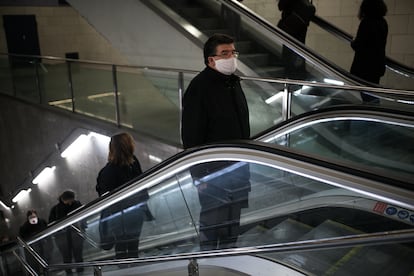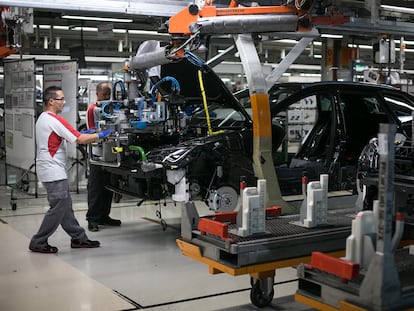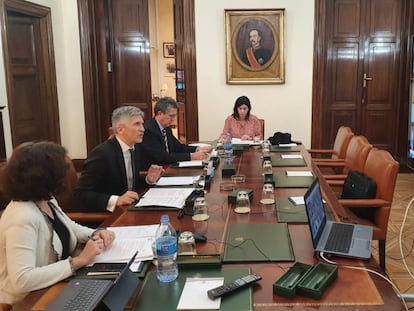Commuters in Spain complain of overcrowding during coronavirus lockdown
Photos of packed trains fill social media, as passengers express concern that they are not able to maintain a safe distance to protect themselves from possible contagion

“It’s worse than the days when there was no pandemic.” That was the complaint of many commuters in Madrid and Barcelona after problems with public transportation led to overcrowding on the first working day of the lockdown to contain the spread of the SARS-CoV-2 coronavirus. On Saturday, the Spanish government declared a state of alarm that has effectively confined all Spaniards to their homes. But many Spaniards still needed to travel on Monday, be it for work defined as essential services or other permitted reasons, such as to take care of seniors.
In Madrid however, a temporary morning breakdown on the Cercanías commuter train network at Príncipe Pío station led to long delays on the C1, C7 and C10 lines. Many also complained that buses and the Metro train station were overcrowded, even though Madrid transit authorities maintained that “service was at 100%.”
impossible mantenir distància de seguretat als vagons del metro de Barcelona. L5 pic.twitter.com/56wuBsUHSN
— Clara Blanchar (@clarablanchar) March 17, 2020
It is imposible to maintain a safe distance on the Barcelona Metro. L5
Amid the crowded trains, commuters took to social media to report that the high volume of passengers made it impossible to maintain a safe distance to prevent possible contagion of the coronavirus.
María José Rallo, the secretary general of the Transportation Ministry, said that there were very few incidents on the Cercanías network in Spain, with occupancy between 20% and 30%.
Meanwhile in Barcelona, the Metro train line saw an “unexpected influx” of passengers before 7am, an hour earlier than the expected rush hour. In many photos shared by social media users, some after 7am, dozens of people were seen crowded into train carriages, many wearing face masks. Ana, who works as a cleaner for the company Avant on Barcelona’s Metro, said she was surprised by how many people flooded into the Sagrada Familia station early in the morning.
Vergüenza @sanidadgob @Adif_es @CercaniasMadrid @Congreso_Es #asino @gpscongreso @GPPopular. #yonomepuedoquedarencasa pic.twitter.com/bOZEbEMs1J
— Lucía (@lucya_77a) March 16, 2020
Shameful.
After 9am, however, the trains were half-empty and passengers were able to maintain a safe distance from one another. The Barcelona Metropolitan Transportation Authority (TMB) announced that it would increase the number of trains on the affected lines “as soon as possible,” and would consider the possibility of “controlling access to the stations” to prevent further overcrowding problems. But despite the promise to increase frequency, it was again difficult for passengers to maintain a 1.5-meter distance inside the carriages on Tuesday.
In response to Monday’s transportation problems, Spain’s UGT labor union called for restrictions to be placed on how many people are allowed on train platforms and in carriages. Representatives of the CCOO union in Madrid Metro also called for workers to be given “gloves, face masks and disinfectant.” “This is imperative; it is unsustainable to work without being provided with protection elements,” said union representative Juan Carlos de la Cruz.
“Of course the Metro is scary, but it would be worse not to have a job to go to”
Latex gloves and face masks. That was what most passengers on the Barcelona Metro were wearing on Tuesday. “Of course it’s scary, but it would be worse not to have a job to go to,” said Fernando, who assembles furniture.
Passengers on the platform were told: “People with symptoms or who belong to an at-risk group should not use public transportation. Distribute yourself across the length of the platform and in the carriage when you enter the train.” The second piece of advice was impossible to follow given the number of people waiting between 7am and 8am on Tuesday.
Inside the train, there were people with all sorts of clothing, from jackets with construction logos, to suits and ties. Some people were not afraid to show their fear and tried uselessly to stand apart from the other passengers. Others, when they got off the train, stood against the wall waiting for everyone to pass. Teresa, a doctor at Barcelona’s Clínic Hospital, was not afraid. She did not wear gloves or a face mask.
English version by Melissa Kitson.









































